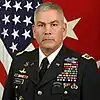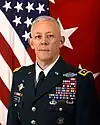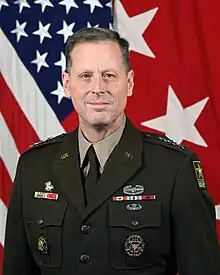
In the US Army, Patrick Matlock is the Deputy Chief of Staff for Operations, Plans, and Training (G-3/5/7) serving on Army Staff for operations (G-3), plans (G-5), and training (G-7). Both G-8 and G-3/5/7 sit on the Army Requirements Oversight Council (AROC), chaired by the Chief of Staff of the Army (CSA). [1][2]
The Army's Force management model[3]: diagram on p.559 begins with a projection of the Future operating environment, in terms of resources: political, military, economic, social, information, infrastructure, physical environment, and the time available to bring the Current army to bear on the situation.[2]
The AROC serves as a discussion forum of these factors.[1]
A DOTMLPF analysis models the factors necessary to change the Current force into a relevant Future force.[2]
The relevant strategy is provided by the Army's leadership to guide Army staff.[3]
The resources are "dictated by Congress".[2]
A JCIDS process identifies the gaps in capability between Current and Future force.[2]
A Force design to meet the materiel gaps is then underway.[2]
An organization with the desired capabilities (manpower, materiel, training) is brought to bear on each gap.[2]
- AR 5-22(pdf) lists the Force modernization proponent for each Army branch, which can be a CoE or Branch proponent leader.
- Army Staff uses a Synchronization meeting before seeking approval —HTAR Force Management 3-2b: "Managing change in any large, complex organization requires the synchronization of many interrelated processes".[3]: p2-27
A budget request is submitted to Congress.[2]
Approved requests then await resource deliveries which then become available to the combatant commanders.[2]
List of Deputy Chiefs of Staff for Operations, Plans, and Training, G-3/5/7
| No. | Deputy Chief of Staff | Term | |||
|---|---|---|---|---|---|
| Portrait | Name | Took office | Left office | Term length | |
| - | Lieutenant General Daniel P. Bolger (born 1957) | 21 May 2010 | 6 September 2011 | 1 year, 108 days | |
| - | Lieutenant General John F. Campbell (born 1957) | 6 September 2011 | 8 March 2013 | 1 year, 183 days | |
| - | Lieutenant General James L. Huggins Jr. | 8 March 2013 | May 2015 | ~2 years, 68 days | |
| - | Lieutenant General Joseph Anderson (born 1959) | May 2015 | 27 June 2019 | ~4 years, 43 days | |
| - | Lieutenant General Charles A. Flynn (born c. 1963) | 27 June 2019 | ~4 June 2021 | ~1 year, 342 days | |
| - | Lieutenant General James Rainey (born 1964/1965) | ~4 June 2021 | 3 October 2022 | ~1 year, 121 days | |
| - | Lieutenant General Patrick Matlock (born 1965) | 3 October 2022 | Incumbent | 1 year, 101 days | |
Notes
- 1 2 Headquarters, Department of the Army (29 Jun 2021) Army Regulation 71–9 Force Management. Warfighting Capabilities Determination °1-6c, p.1) tasks for CG,AFC; °2-24 p.13) CG,AFC is a principal member of AROC, with 43 duties a through qq; °3-1 ch.3 pp20-21) AROC is a forum for requirements decisions (RDF); °4-1 p.24) CG,AFC is responsible for force design; °6-4 p39) figure 6-1 Deliberate staffing and review process; figures for more staffing and review processes follow.
- 1 2 3 4 5 6 7 8 9 James Kennedy (2019) Force Management Model - Complete
- 1 2 3 United States Army War College and Army Force Management School (2019-2020) How the Army Runs HTAR: A senior leader reference handbook which synthesizes "existing and developing National, Defense, Joint, and Army systems, processes, and procedures currently practiced"



.jpg.webp)
.jpg.webp)
.jpg.webp)
